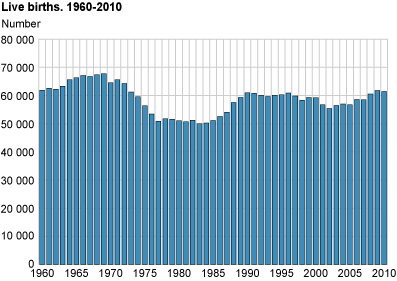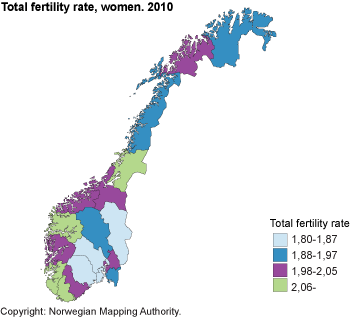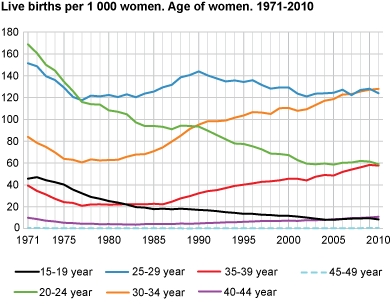Content
Published:
This is an archived release.
Stability in births
A total of 61 400 children were born in Norway in 2010; a decrease of 400 compared with 2009. The total fertility rate was 1.95 children per woman.
The total fertility rate decreased by 0.03 from 2009. The county of Rogaland, Sogn og Fjordane, Nord-Trøndelag and Vest-Agder had a total fertility rate for women of 2.06 or higher. To ensure that the size of the population is maintained in the long term, the total fertility rate should be at least 2.06-2.07 children per woman. Compared with 2009, the county of Telemark had the highest increase in the total fertility rate for women, while the county of Finnmark had the highest decrease.
The total fertility rate for men was 1.75 in 2010. The total fertility rate for men has varied between 1.61 and 1.77 the last 10 years. The level of the total fertility rate is lower for men than for women. One reason for this is the high labour immigration among men in the fertile age groups. The total fertility rate for men is estimated for the age 15-54 years and for women 15-49 years.
30-34 year-olds most fertile
Women aged 30-34 had the highest fertility rate, with 128.0 live births per 1 000 women, followed by women aged 25-29, with 124.0 live births per 1 000 women. Most men who became a father last year were in the age group 30-34 years. In 2010, the average age for women giving birth for the first time was 28.2 years and the average age for men at their first children’s birth was 30.8 years. It seems that the increase in the average age at births since the 1970s is about to flatten out.
Fewer multiple births
In 2010, there were 980 twin births and 22 triple births, which corresponds to 16.5 multiple births per 1 000 births. For 2009 the corresponding figure was 17.6. In 2002 it was 19.4, and since then the number of multiple births per 1 000 births has decreased almost every year.
Few late foetal deaths
In 2010, 190 children were late foetal deaths. This corresponds to 3.1 late foetal deaths per 1 000 births. This is the lowest figure of late foetal deaths per 1 000 births ever registered. In 2010, there were as many late foetal deaths among boys as in 2009, while there was a decrease of 25 late foetal deaths among girls.
Tables:
- Table 1 Live births and late foetal deaths. 1951-2010
- Table 2 Confinements of single and multiple births, by sex. 1991-2010
- Table 3 Age-specific fertility rates and total fertility rate, women. 1961-2010
- Table 4 Average age of parent at child's birth. 1946-2010
- Table 5 Total fertility rate, women, by county. 1968-2010
- Table 6 Age-specific fertility rates and total fertility rate, men. 2000-2010
- Table 7 Live births, by parity. 1978-2010
- Table 8 Live births, by parity, cohabitation status of mother and county. 2010
- Table 9 Number of children distributed, by age and cohort . Per cent
Contact
-
Statistics Norway's Information Centre
E-mail: informasjon@ssb.no
tel.: (+47) 21 09 46 42
-
Espen Andersen
E-mail: espen.andersen@ssb.no
tel.: (+47) 92 61 00 46
-
Ane Margrete Tømmerås
E-mail: ane.tommeras@ssb.no
tel.: (+47) 91 99 29 62
-
Oppdrag befolkningsstatistikk
E-mail: befolkning@ssb.no



